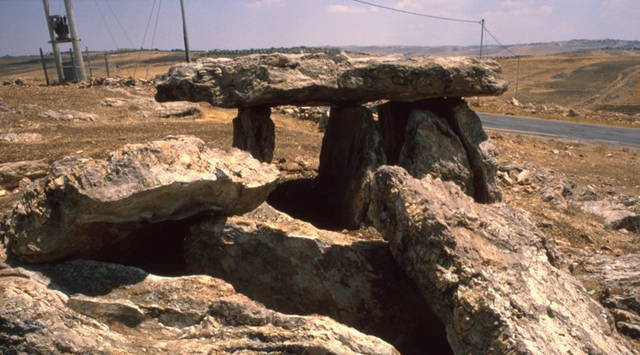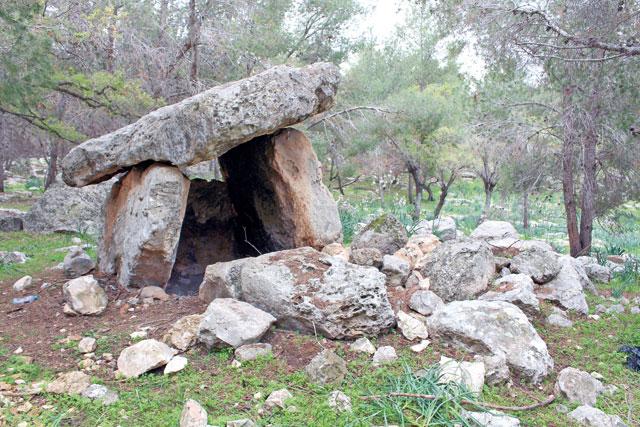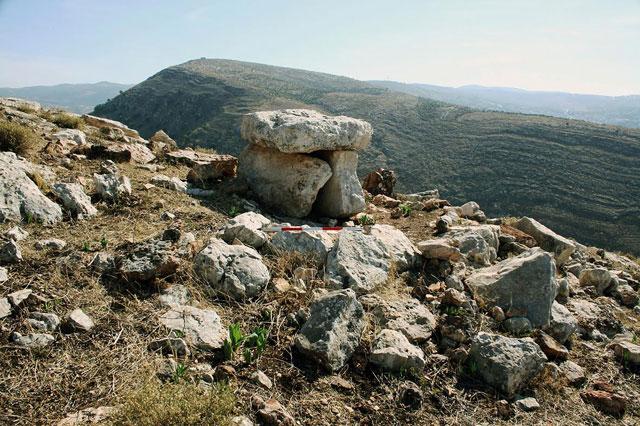You are here
Unveiling Jordan’s ancient dolmens
By Saeb Rawashdeh - Jan 08,2024 - Last updated at Jan 08,2024

A dolmen at Beit Yafa (Photo courtesy of ACOR/ Rami Khouri collection)
AMMAN — There are two typical megalithic structures that can be found in Jordan-dolmens and menhirs.
Dolmens are a single-chamber megalithic tombs consisting of two or more upright megaliths supporting a table, or a flat capstone. The name dolmen derives from the Breton language and means a stone table.
Menhir is an upright single stone, and like dolmens, menhirs can be found in Africa, Asia and Europe. There is a possibility that both structures had been used not only for burials but for mortuary and other pre-historic rituals. In this article we will discuss dolmens that are available mostly in the Jordanian countryside, although some can be detected in urban centres.
Archaeological teams coming to the Levant studied dolmen fields and they are usually located in the central massive stretching from the Asia Minor to southern Jordan and from Galilee and Golan Heights to Madaba Plain and Ma’in.
“In Jordan itself, dolmens are usually concentrated along wadi slopes, on escarpments and clearly limited to areas where the large slabs quarries were readily available and easily transportable,” noted Professor Emeritus Zeidan Kafafi from Yarmouk University in Irbid, adding that dolmens will always be found at a short distance from the original quarry, the specificity of a geological formation being a (co)determining factor for their presence.
Dolmens are widely distributed in Jordan; they can be seen in an area extending from the Jordan Valley in the west until the Badiyah region in the east, and from Syrian border/Yarmouk River in the north down to the towns of Shobak and Maan in the south.
At the moment, the Jordanian Antiquities Database and Information System records 101 different sites, but not all available research has yet been incorporated in the system and new fields are still being discovered, Kafafi underscored, noting that even in urban areas of west Amman, like Tlaa Al Ali, dolmens can be discovered.
“Although an individual dolmen has been signalled, dolmens are normally concentrated in larger numbers,” Kafafi stressed, adding that in Jordan several major dolmen fields can be detected: Irbid/Ajloun, Zarqa Valley, Ma’in and Jordan Valley.
There are multiple types of dolmens: “A dolmen can be defined as a megalithic structure shaped in the form of aresting horizontally on either two or three upright large slabs of stones. In most cases these stone-slabs are unhewn. However, those excavated e.g. at Damiyah [Jordan Valley] are often completely enclosed by four upright slabs: In some of them a small square opening had been carved out, often with an incised frame. Also, dolmens found recently east in the village of Rasoun [Ajloun area] are remarkably neatly carved on the inside,” the professor explained.
Found in a bigger group, dolmens can be of different sizes and shapes. Moreover, a few dolmens at Damiyah and Al Adheimeh still show the remnants of these stone heaps. Very often, the dolmen was constructed upon a (mostly) round circular stone platform, delineated by relatively large boulders, usually measuring between 4 and 6 metres in diameter.
“It has been suggested that the dolmens found in the whole of the Syria-Palestine area, which consist of a limited number of types, belong to one and the same architectural tradition,” Kafafi said, adding that though the dolmen typologies are not completely identical, some scholars classify six general types occurring in the Levant:
First, the basic type is consisting of two upright slabs and a capstone.
Second represents four or more upright slabs and is roofed with one or more capstones.
In the third type, the walls of the chamber were formed by slabs resting horizontally one above the other, rising in step-like tiers and topped by several slabs forming a flat or corbelled ceiling.
Fourth type is rare and consists of a double-chamber with three walls covered by one large capstone.
Fifth is also a very rare type, a double-chamber defined by one chamber on top of the other, formed by inserting a slab into parallel notches cut on both sides of the vertical slabs.
And the sixth is characterised by boulders, hollowed out mostly from above, often with a porthole, covered by a capstone and often surrounded by stone circles. “People have, of course, speculated for many years about the function of the dolmens and their builders. Some speculated that they were built by mysterious race of giants, others saw in them ‘obscure architectural remains of vanished civilisations’, altars for ancient sacrifices, astronomical markers, sign posts for a mysterious communication system or other strange phenomena,” Kafafi claimed,
The lack of actual human sepulchral finds at dolmens have led some researchers to suggest that the dolmen served only as a primary burial place, from where after the bones were later transferred to another, final, resting place, the professor concluded.
“They might even have served sometimes as purely symbolic tombs, which would explain the complete absence of human remains,” Kafafi underlined.
Related Articles
AMMAN — Dolmens, above-ground tombs made of giant slabs of stone, are scattered throughout northwest Jordan, but their absence from other ar
AMMAN — A menhir is an upright stone that can be found across the globe: Middle East, Europe, Africa, South America and Asia.
AMMAN — The monumentality of dolmens, or megalithic stone tombs, has always captured the minds of archaeologists, who find them “the most st














